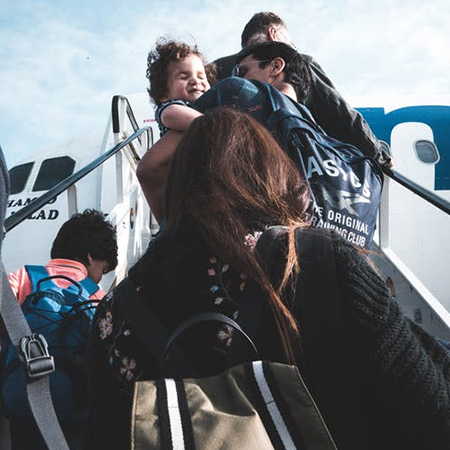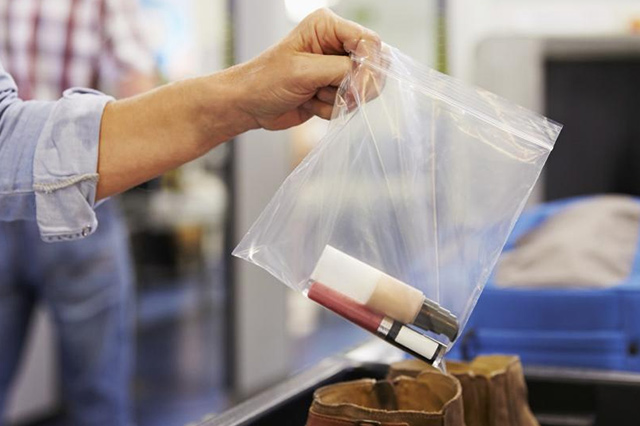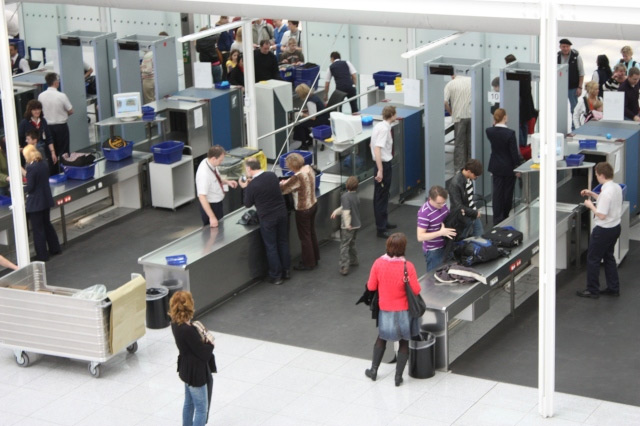
Hollywood celebrity or not, everyone goes through airport security before you can get to your departure gate. And making it through the Transportation Security Administration (TSA) line is nothing less than a refined science brought about by trial, error, and the occasional streak of good luck. Because there’s nothing worse than running late for a flight, only to end up stuck in a security line bottleneck.
This holiday travel season, keep the following tips in mind to make your airport security experience better than your previous one.
Airport Security Tips to Keep in Mind This Holiday Travel Season
Before you go . . .
Place liquids, aerosols, and gels in the appropriate containers.
You know the drill, pack 3-1-1 bags—that is, putting all liquids and gels in 3.4-ounce or smaller containers inside a clear, 1-quart zip-top bag. Save yourself the expense of purchasing travel-sized products, and pick up a clear bag with clear bottles that you can fill with product from your full-size bottles at home. Label your bottles to keep products easy to recognize, and put the bag in a front pocket of your carry-on. Bring your reusable water bottle through security empty, then fill it up after for a refreshing drink on a hot travel day.
Scroll down for video

Portal Turismo Total
Pack medication separately.
You can bring prescription liquid medications through security. You can also bring medically necessary water, juice, and other “liquid nutrition,” as well as frozen liquids or gels that you will use to cool medical items. Prosthetics and medical items are also permitted. The catch? Everything must be screened in some way. Tell the security screeners what medical and disability-related items you have with you and ask them to screen the items visually if x-rays will harm them.
Keep small electronics in your carry-on and large ones in a separate bag.
Your carry-on bag and personal items, like your purse, will be scanned. Your cell phone, loose change, wallet, and watches should be put in a jacket pocket and placed in a bin. On the other hand, airport security requires travelers to remove large electronic items such as laptops, camcorders, and DVD players, from their cases. You’ll have to place each item in its own bin for the x-ray machine. Other electronics like tablets, cameras, or MP3 players can stay in your bag.
Dress down as much as possible.
Wear clothing and shoes without metallic embellishment in order to pass through the metal detectors at the security checkpoint. So choose a cardigan or jacket with a zipper or buttons so you don’t have to pull anything over your head. Wear slip-on shoes or zippered boots. You wouldn’t want to waste time fiddling with a pair of laces, complicated straps and buckles, or yanking off your steel-toe boots. A simple pair of ballet flats for women or slip-on loafers for men will do the trick quite nicely. Put small metal objects—cell phone, watch, keys, coins—in your coat pockets for easy pickup after security.
When you’re there . . .
Pick the fastest-moving line.
A short line at the airport security doesn’t always mean a fast line. It’s best to take a look at the type of people waiting in each line, not the number. A dozen business people might move through security much faster than two families with young children or a tour group of senior citizens. Just remember this equation: one baby carriage equals four typical passengers. Also, aim for the far left or far right lanes. Casual and new travelers just walk straight ahead and end up waiting longer as a result. When traveling with kids under the age of two, remember that you can use the Family / Special Needs line.

Numrush
Ready your paperwork.
You may have no problem holding on to your license in your daily life, but there is something about the hustle and bustle of the airport security process that often results in losing sight of important documents. Boarding passes and passports can easily end up at the bottom of a purse or thoughtlessly put in a jacket pocket. As soon as you enter the security line, have your boarding pass and ID on hand.
Remove your shoes, coats, and accessories before your turn.
You will need to take off your coat or jacket and place it in a plastic bin at the security screening checkpoint. You will also need to remove your shoes and place them, carry-on items, and metal items in bins for x-ray screening. You have to be ready for this, so keep your fellow travelers in mind and remove these before it’s your turn in line.
Prepare laptops and other priority items for screening.
You have to remove laptops and 3-1-1 bags from carry-ons for x-ray screening, so pack them for fast access prior to screening and easy stowing afterward. TSA reserves the right to open wrapped packages, so save some time and trouble by leaving gifts unwrapped. Consider the shapes of any items in your carry-on. Even the smallest trinkets can look suspicious on an x-ray scan. If you think something innocent will set off red flags, put it in the bin for the scan so TSA officers can identify it without having to conduct a bag search.
Keep an eye on your stuff.
Regardless of the hectic atmosphere at the security screening point, pay attention to your surroundings in order for you to avoid lost luggage situation. If you rush through the screening process, you may forget to take one of your personal items with you. Even worse, you could be a theft target, as pickpockets are known to frequent airport security screening areas. Always be mindful and keep a hand on your purse or laptop as you put your shoes and coat back on. We also hope you secured your luggage with GPS trackers as losing luggage has become quite common!
Airport Security — the Bottom Line
The airport security screening process, while annoying and time-consuming, is conducted for an important purpose. TSA officials have confiscated guns, bullets, knives, hand grenades, drugs, and other items from travelers. So ready your patience and politeness by the time you get there. After all, each step in line is a step closer to your next travel adventure!
Watch the video below